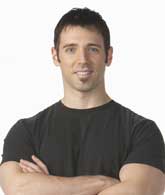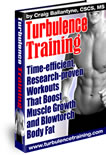Changing Nutrition Habits
 A food journal is an excellent motivating tool that can help you change your bad eating habits. In part 2, of this interview series Dr. Berardi gives a few simple ideas on how to track your nutrition and exercise routines.
A food journal is an excellent motivating tool that can help you change your bad eating habits. In part 2, of this interview series Dr. Berardi gives a few simple ideas on how to track your nutrition and exercise routines.
Today, Dr. Berardi’s describes how the Precision Nutrition program provides unique coaching methods that recondition your habits as well as it brings an understanding to the unique approach to the physiological and psychological effects it has on our eating habits.
*******************
Craig: I would like to start off with our next question which is more for our beginners. We do have quite a few of them coming in through Facebook and through our Turbulence Training reports. What are some of the simplest yet most effective changes that someone who is really new to this stuff can do for fat loss? I also get a lot of questions from people who are always asking, what are the best ways to determine how many calories they need?
John: Definitely good questions, Craig. With our coaching program, we actually use a series of questionnaires and assessments to determine what level a client is when they come to see us. There are generally three levels that most clients fall into.
Level one, are the clients or the people who are completely new to eating well. In simple terms a level one client is someone who would ask, “What’s a protein? What foods have protein in them?”
Level two clients are the types of people who demonstrate some understanding of good nutrition yet need guidance, planning and direction. So, a level two client might say, “I eat pretty healthy, but I still have trouble sometimes losing weight.”
Then the level three clients, these are the people who eat the right foods in the right amounts at the right times, but they’re trying to achieve higher level goals like to improve on their physique or training for some sort of athletic competition. So, to put a tag line on a level three client this is a person who says, “Hey, here’s my nutritional spreadsheet. Take a look.”
So you can see when you have these three types of mentalities, there are three types of experience sets, each level is going to require a different approach. If a level one client says, “What’s a protein?” we certainly can’t give them the level of detail in our coaching that give to someone who says, “Here’s my nutritional spreadsheet. What do I need to change?”
So, back to your original question. With the level one clients, we basically approach one habit at a time, because people who are entirely new to eating well have a tendency to become quite overwhelmed with the changes they have to make through exercise and nutrition. These are the people, who end up quitting early, or they try to adopt 20 different habits at once, and they burn out after a couple of months wondering what the heck happened.
With our coaching, we select one of the person’s habits that create the biggest physiological change. I refer to this as the lowest psychological resistance, and it’s an important combination. So, what can you find has a big physical impact that someone can do psychologically?
Well, for example, we have Lean Eating coaching. The first habit is to start off with one gram of fish oil per one percent body fat. When people are new to the program that’s the number one thing they start with. We do that up to about 30 grams, so if someone is 20 percent body fat, they take 20 grams of fish oil a day. If they’re 30 percent, they take 30 grams a day.
We also have them throw a multivitamin in there each day. So, habit number one is fish oil, one gram per percent body fat, and then a multivitamin. We do this as the first habit because it’s really effective. For starters, physiologically it kicks starts the body’s fat loss by increasing metabolism, along with so many other benefits. It can improve skin quality, and it helps you feel more satiated at each meal.
There’s also some new research showing that it fish oil impacts the motivation “centers” in the brain. So, people may be more motivated to follow their exercise plan as well as their good nutrition habits when they’re taking fish oil at this dose. So, there’s this great physiological side.
However, on the psychological side it’s actually a habit that’s pretty easy to do, and it fosters habit building and positive momentum. These are all great things when starting a fat loss program. So, that’s the first thing I recommend to people when they come into our coaching, as you can see it has a positive physiological and a psychological perspective.
Then every two weeks from there we add another habit. The second habit in our program is eating the “most carb dense” meals after exercise. This is another really effective one physiologically and psychologically. By eating our carb heavy foods like pastas, bread, rice, stuff like that after exercise only is going to do something for you physiologically. So the idea is to TAKE BETTER CONTROL of your overall calorie intake by use the carbs when they are less likely to convert to body fat by creating a menu that’s rich in proteins, veggies, and good fats during the non-exercise periods.
So, this one simple habit helps us realign our entire diet allowing us to start thinking about each meal a little more differently. We’re also is doing something psychologically by creating a trigger habit. You’ve got to earn those pastas, rice, and breads by exercising first. So, if you don’t plan on exercising then you want stick to the lower density carbs like legumes and veggies and lean proteins, BUT if you do exercise you earn these other foods.
These are the two habits that we start our level one client’s off with, and you can see there’s more to it than just the physiology. We’re actually doing things that can lead to the biggest physiological impact right away while offering the lowest psychological resistance.
Now, let’s move on to the other part of your question. We actually don’t count calories with our level one client’s. I do believe that calorie control is important, but I don’t think you need to count calories to control them. In fact, we only start counting calories with high level two or level three type clients.
Craig: Very cool. There’s one question I wanted to ask you. You mentioned when you were talking about your record keeping and how it was very old school. Have you moved into the high tech generation? Do you guys have a Precision Nutrition iPhone application or anything cool like that?
John: We don’t have an iPhone app or anything like that. However, we actually created a web interface with our Lean Eating and our Scrawny to Brawny coaching. That sounds all fancy, but it’s basically a web page that people log into every day and essentially do the old school things with a few high tech bells and whistles. For example, in our coaching program every day you login you’re presented with a workout for the day, so you can print off a PDF with the exercises that has set and rep scheme all laid out for you. However, there’s also video so you can actually either download them to your iPhone or just watch them online instructing you on how to do each exercise so that when you get to the gym you know what you’re doing.
Furthermore, there’s a lesson of the day. It’s a lesson that has to do with your current nutrition habit asking you two simple questions. One is, “Did you do your workout today?” There are a couple of options that you can select from like;
1) “Yes, I did it, and I totally rocked it.”
2) “Yes, I did it, but I only got a portion of it.”
3) “No, I missed today’s, but I’ll be back on track tomorrow.”
Then there’s a habit question, and it asks, “Did you do your nutrition habit today? And you get to select “yes” or “no”. Then it presents the habit that you should be following for those two weeks. Then there’s also a place where you can put your notes. It seems very simple. To be honest with you, it’s really cool because when you actually say “yes” that you did your workout, and you did your habit, which is the equivalent of getting the double checkmark on your calendar, there’s this animated icon that comes up, and it’s a green check mark that goes over to your progress meter.
So, your progress meter builds up with each day of successful habits. Now, that may sound like a small thing, but I can tell you that every single person who goes through our coaching program loves the green check-marks. It’s a cool little animated feature that builds up your rep points, if you will.
There are actually a couple of cool studies that we found that sort of sparked ad motivated this sort of thing basing it on the “high technology” things. One study was pretty cool; it was sort of a “lifestyle change” phone application. Basically, it was your homepage or screen saver for your phone that looked like a field of flowers. You’re assigned these habits to do each day and when you did your habits the field of flowers would sort of blossom. So, you’d get more flowers in the field and the flowers that were there would thrive.
When you didn’t do your habit some flowers would start dying off. If you were very successful with the changes that we’re being asked of you, you’d have this beautiful field of wonderful flowers, and if you weren’t successful you would see this dying field every time you opened up your cell phone.
It was amazing because when they added this as a part of the intervention people were so much more likely to do their required habits and get the results.
You might say with fitness, for example, “What does a field of flowers have to do with that?” It doesn’t have a lot to do on a rational level, but on a pre-rational level what you’re doing is you’re tending your garden, you’re caring for yourself just like you’re caring for this field of flowers. So, we actually applied that in a little of a different way based on some other studies we found, but that’s part of the high tech aspect, of how we record what people are doing and reward them for successful behaviors.
OUR COACHING PROGRAM IS AS SIMPLE as it needs to be so that it’s not confusing, but it’s also as technologically advanced providing the appropriate accountability and reward structures. So, it’s pretty neat.
In part 4 with Dr. Berardi we’ll take a look at we should be eating on a daily basis.